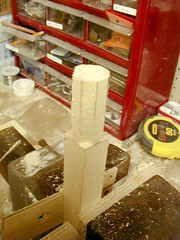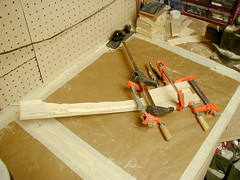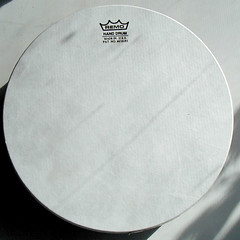Tenor #1: Neck, Part II
At the outset of this project, I had been planning to use black formica for the fingerboard and peghead overlay. Eventually I decided to spring for a rosewood fingerboard, but I had to draw the line there... I couldn't quite talk myself into spending the money for an ebony peghead overlay too.
I don't want to use formica next to a nice rosewood fingerboard, though, so I took a tip from the Banjo Makers group and bought myself a bottle of black shoe leather dye at the drugstore. I managed to fashion a thin piece of maple about 3" x 7" x ~1/8" from a scrap of 1x3. I was able to scrape it thin by dragging it diagonally across the bandsaw blade, and by the time I sanded all of the saw marks smooth it looked pretty good. It is not thickness sanded and it's certainly not the 3/32" you can get from Stewmac, but I think it will work. The leather dye works nicely, darkening the wood without hiding the grain.
The tricky part will be removing the extra wood from the peghead itself; the faux ebony overlay will add noticeable depth to it.
I don't want to use formica next to a nice rosewood fingerboard, though, so I took a tip from the Banjo Makers group and bought myself a bottle of black shoe leather dye at the drugstore. I managed to fashion a thin piece of maple about 3" x 7" x ~1/8" from a scrap of 1x3. I was able to scrape it thin by dragging it diagonally across the bandsaw blade, and by the time I sanded all of the saw marks smooth it looked pretty good. It is not thickness sanded and it's certainly not the 3/32" you can get from Stewmac, but I think it will work. The leather dye works nicely, darkening the wood without hiding the grain.
The tricky part will be removing the extra wood from the peghead itself; the faux ebony overlay will add noticeable depth to it.





